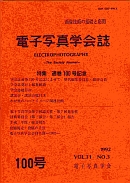Volume 30, Issue 4
Displaying 1-17 of 17 articles from this issue
- |<
- <
- 1
- >
- >|
-
1991Volume 30Issue 4 Pages 398-402
Published: 1991
Released on J-STAGE: March 14, 2008
Download PDF (465K) -
1991Volume 30Issue 4 Pages 403-410
Published: 1991
Released on J-STAGE: March 14, 2008
Download PDF (991K) -
1991Volume 30Issue 4 Pages 411-417
Published: 1991
Released on J-STAGE: March 14, 2008
Download PDF (844K) -
1991Volume 30Issue 4 Pages 418-425
Published: 1991
Released on J-STAGE: March 14, 2008
Download PDF (1276K) -
1991Volume 30Issue 4 Pages 426-431
Published: 1991
Released on J-STAGE: March 14, 2008
Download PDF (1315K) -
1991Volume 30Issue 4 Pages 432-438
Published: 1991
Released on J-STAGE: March 14, 2008
Download PDF (894K) -
1991Volume 30Issue 4 Pages 439-444
Published: 1991
Released on J-STAGE: March 14, 2008
Download PDF (1799K) -
1991Volume 30Issue 4 Pages 445-451
Published: 1991
Released on J-STAGE: March 14, 2008
Download PDF (904K) -
1991Volume 30Issue 4 Pages 452-458
Published: 1991
Released on J-STAGE: March 14, 2008
Download PDF (766K) -
1991Volume 30Issue 4 Pages 460-466
Published: 1991
Released on J-STAGE: March 14, 2008
Download PDF (1037K) -
1991Volume 30Issue 4 Pages 467-476
Published: 1991
Released on J-STAGE: March 14, 2008
Download PDF (2044K) -
1991Volume 30Issue 4 Pages 477-488
Published: 1991
Released on J-STAGE: March 14, 2008
Download PDF (4797K) -
1991Volume 30Issue 4 Pages 489-494
Published: 1991
Released on J-STAGE: March 14, 2008
Download PDF (2940K) -
1991Volume 30Issue 4 Pages 495-501
Published: 1991
Released on J-STAGE: March 14, 2008
Download PDF (1281K) -
1991Volume 30Issue 4 Pages 502-507
Published: 1991
Released on J-STAGE: March 14, 2008
Download PDF (3068K) -
1991Volume 30Issue 4 Pages 508-512
Published: 1991
Released on J-STAGE: March 14, 2008
Download PDF (1181K) -
1991Volume 30Issue 4 Pages 513-521
Published: 1991
Released on J-STAGE: March 14, 2008
Download PDF (1175K)
- |<
- <
- 1
- >
- >|
